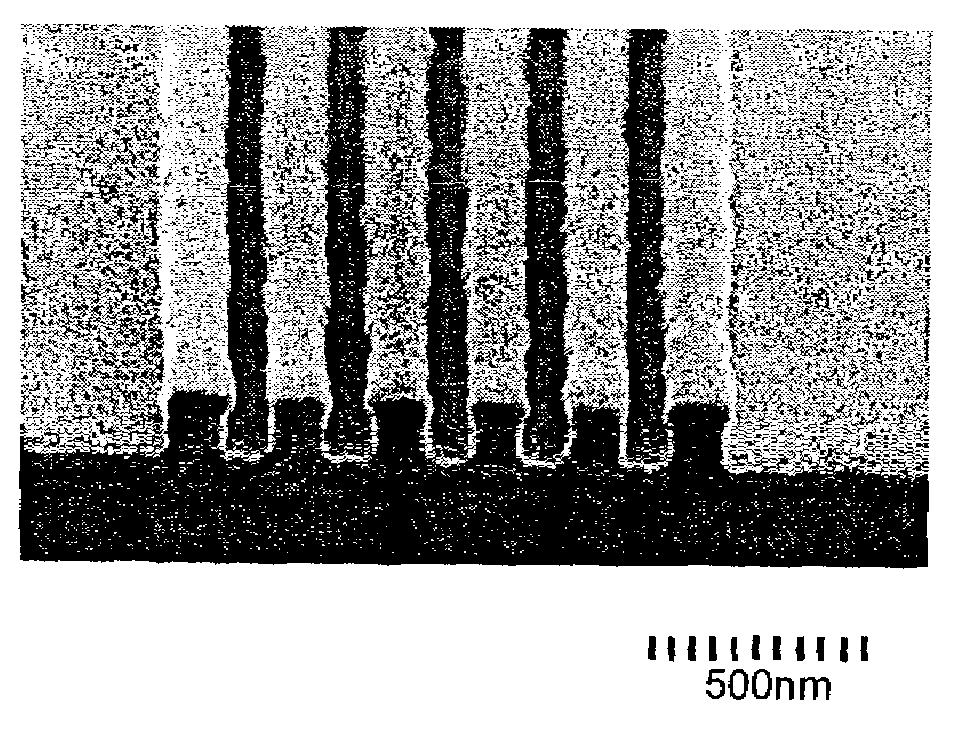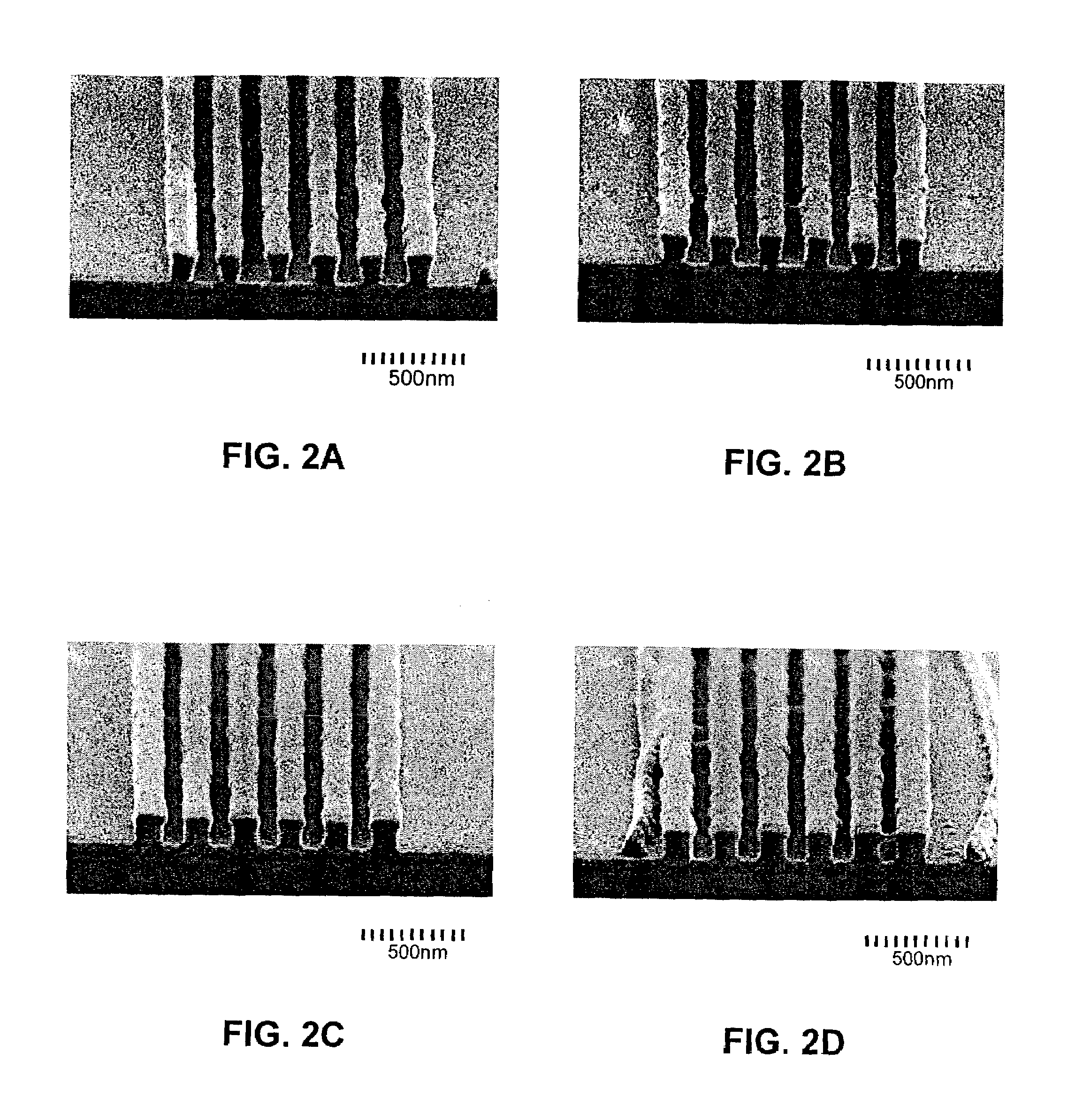Fluorinated vinyl ethers, copolymers thereof, and use in lithographic photoresist compositions
a technology of fluorinated vinyl ether and copolymer, which is applied in the field of polymer chemistry, lithography, semiconductor fabrication, etc., can solve the problems of increasing the polarity of the polymer, unsuitable, and mtfma's resistance to radical homopolymerization, so as to improve the adhesion and environmental stability, the effect of excellent transparency
- Summary
- Abstract
- Description
- Claims
- Application Information
AI Technical Summary
Benefits of technology
Problems solved by technology
Method used
Image
Examples
example 1
Synthesis of 1,1,1-trifluoro-2-trifluoromethyl-5-vinyloxy-pentan-2-ol (VE-PrHFA)
[0129](a) Preparation of 1,1,1-trifluoro-2-trifluoromethyl-2,5-pentanediol and 1,1,1-trifluoro-2-trifluoromethyl-2,4-pentanediol: To a 3-necked, 3-L round bottomed flask equipped with an overhead stirrer, digital thermometer and a 1-L constant-pressure addition funnel with a nitrogen inlet was added 974 mL (1.95 mol) of borane-dimethylsulfide complex (2.0 M in tetrahydrofuran). The addition funnel was charged with a solution of 353 g (1.7 mol) of 1,1,1-trifluoro-2-trifluoromethyl-4-penten-2-ol in 400 mL of anhydrous tetrahydrofuran. The flask was cooled and the olefin was added slowly with stirring while maintaining a temperature below 15° C. The mixture was stirred at room temperature for two days after which time it was recooled and 750 mL (2.25 mol) of 3M NaOH was added carefully. The reaction mixture was reduced in volume on a rotary evaporator and subsequently co-evaporated with two 500 mL portions ...
example 2
Alternative Synthesis of VE-PrHFA Using Mercuric Acetate
[0133]To a 500-mL, 3-necked round bottomed flask equipped with a nitrogen inlet, digital thermometer and magnetic stir bar was added 45 g (0.2 mol) of 1,1,1-trifluoro-2-trifluoromethyl-2,5-pentanediol (prepared in part (a) of Example 1), 300 g (4.2 mol) of ethyl vinyl ether and 2.5 g (0.008 mol) of mercuric acetate and the solution stirred at room temperature for 2 days. The mixture was evaporated on a rotary evaporator, diluted with 500 mL of diethyl ether and washed sequentially with saturated sodium bicarbonate, water and brine. After stirring over anhydrous magnesium sulfate overnight, the suspension was filtered, the solvent removed on a rotary evaporator and the resulting oil filtered through a plug of silica gel as a hexane solution. Hexane was evaporated and the resulting oil distilled four times at 70° C. @ 15 mmHg. The best fractions were pooled to yield 17.5 g (35%) of the product as a clear, colorless oil.
example 3
Synthesis of 1,1,1,3,3,3-Hexafluoro-(6- or 5-)vinyloxy-bicyclo[2.2.1]hept-2-ylmethyl)-propan-2-ol (VE-NBHFA)
[0134](a) Preparation of 2-hydroxy-5-[(1′,1′,1′-trifluoro-2′-trifluoromethyl-2′-hydroxy)propyl]norbornane: To a 3-necked, 500-mL round bottomed flask equipped with a condenser (nitrogen inlet), digital thermometer and magnetic stir bar was added 173.2 g (0.63 mol) of 5-[(1′,1′,1′-trifluoro-2′-trifluoromethyl-2′-hydroxy)propyl]-2-norbornene and 100 g (1.9 mol) of formic acid (88%) and the mixture heated at 100° C. under nitrogen overnight. The resulting yellow solution was evaporated on a rotary evaporator leaving a thick yellow oil to which was added 120 mL of concentrated ammonium hydroxide (28%) and the mixture heated with stirring at 60° C. overnight. After cooling, the layers were separated and the lower layer was diluted with 500 mL of diethyl ether and washed sequentially with 5% (v / v) HCl (2×250 mL), water (2×200 mL) and brine. The ether solution was dried over MgSO4, e...
PUM
| Property | Measurement | Unit |
|---|---|---|
| wavelength | aaaaa | aaaaa |
| wavelength | aaaaa | aaaaa |
| wavelength | aaaaa | aaaaa |
Abstract
Description
Claims
Application Information
 Login to View More
Login to View More - R&D
- Intellectual Property
- Life Sciences
- Materials
- Tech Scout
- Unparalleled Data Quality
- Higher Quality Content
- 60% Fewer Hallucinations
Browse by: Latest US Patents, China's latest patents, Technical Efficacy Thesaurus, Application Domain, Technology Topic, Popular Technical Reports.
© 2025 PatSnap. All rights reserved.Legal|Privacy policy|Modern Slavery Act Transparency Statement|Sitemap|About US| Contact US: help@patsnap.com



